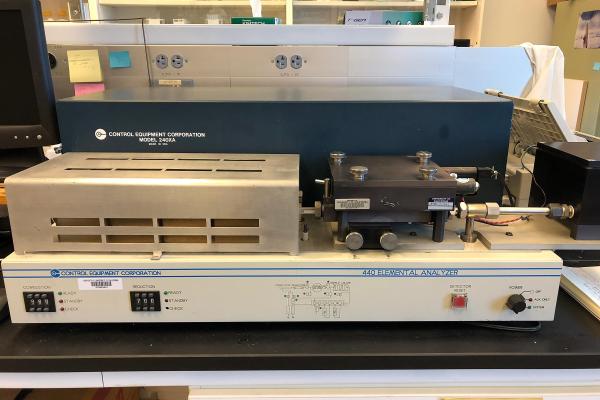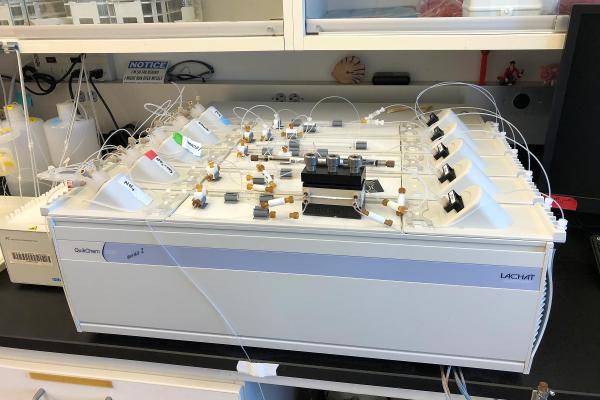The services offered include Seawater nutrients and Elemental (CHN) analysis.

Service Provided: Simultaneous determination of the carbon, hydrogen, and nitrogen content in solid materials. The MSI Analytical Lab will prepare samples for analysis including drying, weighing and loading samples into tin capsules.
Technique Used: Automated Organic Elemental Analyzer (Dumas combustion method)
Sensitivity Range and Precision:
| Analyte | Optimal Range | Detection Limit | Precision |
|---|---|---|---|
| Carbon, C | 50 - 3000 ug | 2 - 7 ug | +/- 0.3% |
| Hydrogen, H | 100+ ug | 5 - 15 ug | +/- 0.3% |
| Nitrogen, N | 15+ ug | 1 - 2 ug | +/- 0.3% |
Sample Collection and Preparation
Before collecting samples, filters must be pre-combusted at 450°C for 30 minutes. Whatman filters, either GFC or GFF, provide low background contamination and are highly preferred. Filters up to 25mm in diameter are analyzed whole and are considered as 'Regular' on our rate schedule. Larger filters up to 47mm in diameter are too big to analyze whole and must be cut in half for analysis. Both halves are analyzed simultaneously, but these samples fall under the "Double-drop" analysis on our rate schedule.
After collection, filters should be placed in a 60°C drying oven and must be submitted completely dry. They should contain no more than 4mg of dried material. If more than 4mg of material is present, or if you have other concerns, please contact the Analytical Lab. Be sure to include filter blanks along with the samples.
Filters submitted to the Analytical Lab for Organic Carbon analysis (TOC) should be treated with 10% v/v hydrochloric acid (HCl) to remove inorganic carbonates. After acidification, filters should be placed in a 60°C drying oven and must be submitted completely dry. The Analytical Lab can provide the acidification service upon request.
Glass or plastic scintillation-type vials are the preferred containers, but plastic petri dishes with lids or glassine envelopes work well also. Wrapping filters in aluminum foil is not recommended as filters have a tendency to stick to the foil during drying and sample losses may occur.
Biological samples typically require 2-3mg of sample per analysis. For materials with low organic content, a larger amount of material will be analyzed to obtain a signal within the optimal range. We ask that 10-100mg of sample be provided. If less than 10mg of material is available, or if you have other concerns, please contact the Analytical Lab.
Samples must be thoroughly dried and finely ground to a powder. Sample homogeneity is usually the limiting factor for analytical precision.
Biological materials submitted to the Analytical Lab for Organic Carbon analysis (TOC) should be treated with acid (H2SO3) to remove inorganic carbonates. It is best to weigh samples into silver capsules first, then acidify gently with multiple aliquots of H2SO3. After acidification, samples should be placed in a 60°C drying oven to dry completely before closing the sliver capsule. The Analytical Lab can no longer provide the acidification service.
Screw-cap glass vials are the preferred containers.
Geological samples typically require 10-50mg of sample per analysis. For materials with ultra low organic content, two aliquots may be analyzed simultaneously. These samples fall under the "Double-drop" analysis on our rate schedule. We ask that 100-1000mg of sample be provided.
Samples must be thoroughly dried and finely ground to a powder. Sample homogeneity is usually the limiting factor for analytical precision.
Geological materials submitted to the Analytical Lab for Organic Carbon analysis (TOC) should be treated with acid (H2SO3) to remove inorganic carbonates. It is best to weigh samples into silver capsules first, then acidify gently with multiple aliquots of H2SO3. After acidification, samples should be placed in a 60°C drying oven to dry completely before closing the sliver capsule. The Analytical Lab can no longer provide the acidification service.
Screw-cap glass vials are the preferred sample containers.
Synthetic samples typically require 1-2mg of sample per analysis, but sample size requirements vary depending on the theoretical elemental composition. We ask that 10mg of sample be provided. If less than 10mg of material is available, or if you have other concerns, please contact the Analytical Lab.
Samples must be thoroughly dried and finely ground to a powder. Sample homogeneity is usually the limiting factor for analytical precision.
Screw-cap glass vials are the preferred sample containers.
The Analytical Lab does not prepare samples for analysis in a glove box. If you are submitting air sensitive or hazardous materials, please contact the Analytical Lab with details and we'll do our best to work with you.

Services Provided: Analysis of seawater samples for dissolved inorganic nutrients. We also have methodologies for analysis of other aqueous samples, such as fresh waters, estuarine waters, ground waters, and neutralized digests.
Technique Used: Flow Injection Analysis, simultaneous
Concentration Range and Precision:
| Analyte | Concentration Range | Precision |
|---|---|---|
| Nitrate (NO3) + Nitrite (NO2) | 0.1 - 300 μM | +/-5% |
| Nitrite (NO2) | 0.1 - 100 μM | +/-5% |
| Phosphate (PO4) | 0.1 - 40 μM | +/-5% |
| Silicic Acid (Si(OH)4) | 0.1 - 500 μM | +/-5% |
| Ammonium (NH4) | 0.2 - 25 μM | +/-5% |
Samples for nutrient analysis should be filtered through a 0.4um polycarbonate filter. Unfiltered, turbid, or samples with widely varying concentrations within a batch of samples may require dilutions or manipulations. These samples fall in the 'Other' category as found on the rate schedule. Samples should be collected in clean, pre-rinsed glass or plastic HDPE 20ml scintillation vials. Samples being analyzed for Si(OH)4 must be collected in plastic HDPE vials. For all other analytes, glass or plastic HDPE containers are acceptable. Some adsorption of PO4 during storage in plastic containers has been noted, so glass may be preferred if PO4 is to be determined. Caps should have a plastic liner. All foil lined lids should be avoided.
Storage blanks are required if NH4 is to be measured. Storage blanks are recommended for all other analytes to detect possible contamination.
A minimum of 5mL of sample is required for the determination of a single nutrient species. 12-17mL of sample is necessary for simultaneous determination of all analytes. It is entirely unnecessary to submit more than 20mL of sample. If you must submit more than 20mL of sample or have other volume concerns, please contact the Analytical Lab.
Mark all samples clearly and directly on the sample container, as well as the lid. If you plan on shipping samples, any masking tape or colored lab-style tape placed on sample vials will fall off during shipment if in the presence of dry ice. Do not use these types of tape to label samples if you plan on shipping samples on dry ice.
Samples should be frozen immediately after collection and stored at -20°C or below. Please allow sufficient headspace when freezing for expansion of the sample without breaking the container.
Do not acidify samples for nutrient analysis.
Please ship samples overnight express using insulated shipping containers and dry ice to keep the samples frozen during transport.